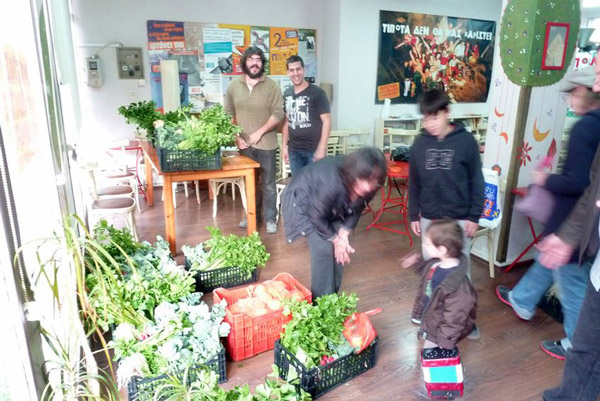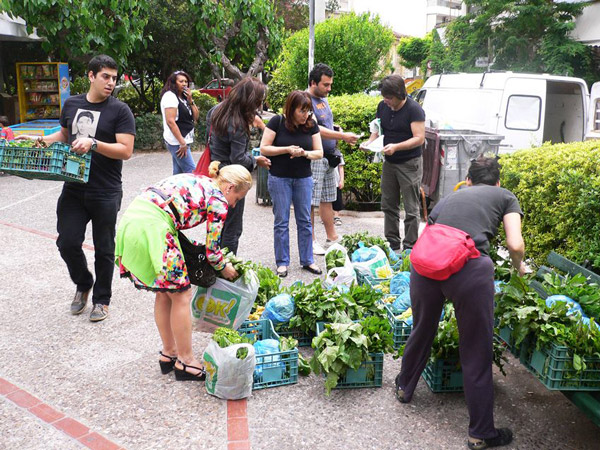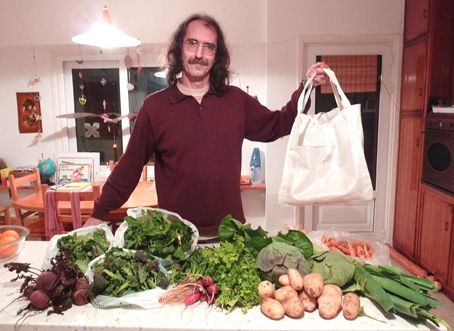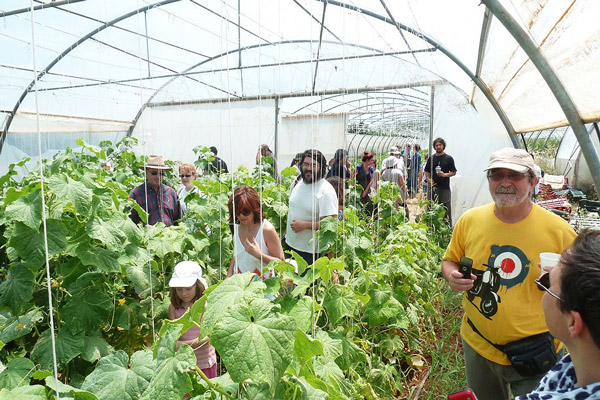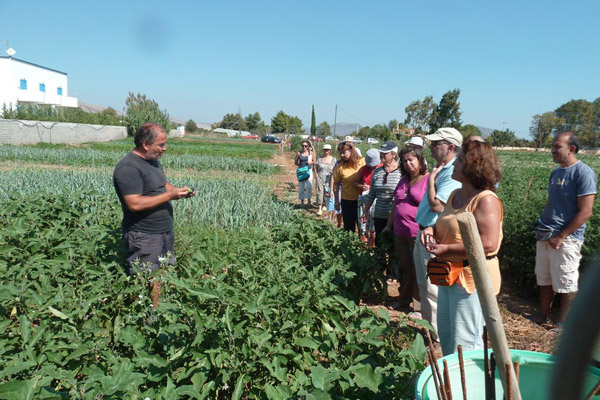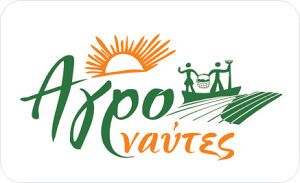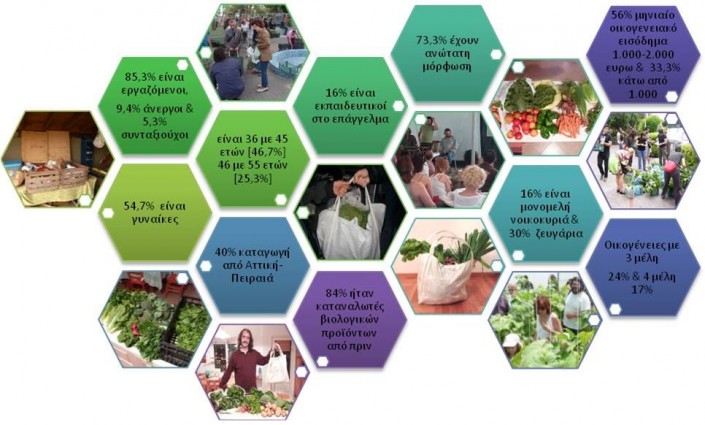"Agronauts" in the city. Vegetable baskets in the city’s neighbourhoods and Community Supported Agriculture
Anthopoulou Theodosia|Partalidou Maria
Quartiers, Social economy
2015 | Dec
Community Supported Agriculture introduces the concept of solidarity agriculture through the mutually beneficial cooperation of a producer (or a group of producers in a rural area) and a group of consumers in a city. Every week, producers supply consumers with a basket of fresh organic vegetables (and sometimes other farm products, such as fruit, eggs, poultry, milk…), based on an agreement made at the beginning of the growing season. The agreement predetermines the range of the basket’s products depending on the season and its cost, at a price that is fair for both parties. Consumers prepay for the seasonal baskets, thus actively supporting the producer (Cox et al. 2008).
Community Supported Agriculture (CSA) is an alternative model for organising agricultural production and the entire agro-food chain, at a territorial level, without trade intermediaries. Producers come into direct contact with consumers in the group, to discuss and jointly decide on cultivation practices, the content of the basket and practical issues regarding deliveries and payments. In short, this is yet another form of a short food supply chain, where farmers and consumers develop close ties, based on mutual trust, within the framework of a nascent “network of citizens” (Renting et al. 2012). In this way, the responsibilities, risks and rewards of farming are shared by all. For producers, participation in a CSA network offers financial security, thanks to assured purchases even in adverse growing seasons, tackling natural and economic risks. Consumers are given the opportunity to follow a balanced healthy diet, to rediscover their connection with the countryside and to be active citizens, contributing to the preservation of the environment and biodiversity (organic farming, use of local seeds) and the socio-economic fabric of rural communities.
A variety of such systems, which expand local markets and small distribution networks, are essentially voluntary steps and collective initiatives (Allaire, 2013).They may be led by farmers, such as the well-known AMAPs in France (Association for the Conservation of Territorial Agriculture) or by consumers, such as the Gruppi di Acquisto Solidale (Solidarity Purchasing Groups in Italy) or even guided by distribution networks (such as solidarity trade). In any case, CSA defends and supports small family farming and domestic processing, local products with a designated origin and distinct taste, organic and biodynamic production methods by environmentally conscious producers who nurture biodiversity, protect public health and work against price volatility. CSA targets the city’s active consumers who are critical of large transnational distribution networks and the global food industry.
CSA developed in Europe in the 1960s (particularly in Switzerland and Germany) when cities started spreading rapidly, while agriculture was cut off from industrial production areas and rural societies were caught in the turmoil of rural modernisation and industrialisation. The CSA movement is currently gaining ground as dietary risks intensify and the journey of food from farm to table lengthens. Today, various CSA schemes exist in different forms around the world. The central idea may be the same, but its implementation, its name, the structure of the network and the extent of commitment are different (Schlicht et al. 2014).
In Greece, CSA or Community Supported Agricultural Production (CSAP) was first launched in an early form as late as 2010-11, with the voluntary initiative of the ‘Agronauts’, the first network between organic farmers in the Peloponnese with consumers in Athens. The first distributions of vegetable baskets started in 2011-12, with three consumer groups in Halandri, Vrilissia and Pangrati. The ‘Agronauts’ were initially distributing 20-30 baskets per group and then expanded to Aghia Paraskevi, Kifissia, Thisio, Exarchia, Kypseli and elsewhere. Two dynamic organic farmers from Attica, who are the main vegetable suppliers of the the greater metropolitan area of Athens, have now joined forces with other participating growers from Laconia, Arcadia and Corinth. “Meet the farmers, so that you know where your food comes from. Become part of a nutritional revolution!” the ‘Agronauts’ urge on their website (http://agronaftes.blogspot.gr/).
One of the first and most dynamic ‘Agronaut’ group is that of Halandri, which started in March 2012 in direct cooperation with an organic farmer from Kiourka, near Lake Marathon and provides 15-25 baskets every week. On the day before delivery, consumers using the network confirm their order by e-mail or text message to either of the two volunteer CSAP coordinators who “apart from dealing with orders and improving the process, are there to talk with consumers and our producer so that we can further build our cooperation” (Thomas Anemos, pioneer Argonaut). The basket, in reality a large white eco-friendly bag that is returned empty at the next delivery, includes about ten kilos of 7-10 seasonal vegetable types, which have been picked in the morning of the delivery day.
| “We have consumers from all social strata and age groups… young couples, people with young children, elderly, middle-income and poor people but not the rich (…). It is worth it, because beyond receiving a quality product, the market comes to you and the products are relatively inexpensive, fresher and cheaper than the packaged organic products found in supermarkets (…). Every week, we distribute at least 250 baskets in about 25 delivery points”
(Athanasia, orders coordinator for the organic farmer in Kiourka, Photo 2). |
In this first phase of operation of the Halandri group, the basket is paid for upon delivery, while the ‘Agronauts’ are promoted by word of mouth, through their website and by organising visits and eco-feasts at the farm of the organic farmer in Kiourka.
| “I consume vegetables I never used to buy before, such as radishes for example… some I had never heard of before, because you can’t find them on the market, such as fresh garlic… what’s more, I no longer have to queue in supermarkets. I believe this is a very smart system, I do not understand why it has not become more popular. It is very convenient for families, and children learn to eat a healthy variety (…). The other day, we went to the farm; it was a great educational process for the children, creating a good relationship with the producer, with the earth, the field, and it was good fun!”
(Kostas, Agronaut). |
Entry citation
Anthopoulou, T., Partalidou, M. (2015) “Agronauts” in the city. Vegetable baskets in the city’s neighbourhoods and Community Supported Agriculture, in Maloutas T., Spyrellis S. (eds) Athens Social Atlas. Digital compendium of texts and visual material. URL: https://www.athenssocialatlas.gr/en/article/agronauts-in-the-city/ , DOI: 10.17902/20971.28
Atlas citation
Maloutas T., Spyrellis S. (eds) (2015) Athens Social Atlas. Digital compendium of texts and visual material. URL: https://www.athenssocialatlas.gr/en/ , DOI: 10.17902/20971.9
References
- Allaire G (2013) Προϊόντα του τόπου (terroir): πολιτισμικές διαστάσεις και προσδοκίες της κοινωνίας. 1η έκδ. Στο: Ανθοπούλου Θ (επιμ.), Περί εντοπιότητας και ιδιοτυπίας των τροφίμων. Μια εδαφική προσέγγιση της ανάπτυξης των αγροτικών περιοχών, Αθήνα: Εκδόσεις Παπαζήση, σσ 106–120.
- Παρταλίδου Μ και Ανθοπούλου Θ (2015) Εναλλακτικά αγροτροφικά δίκτυα και νέες αλληλέγγυες εταιρικότητες μεταξύ πόλης και υπαίθρου. Διερευνώντας την κοινοτικά υποστηριζόμενη γεωργία. Γεωγραφίες 25: 13–23.
- Cox R, Holloway L, Venn L, et al. (2008) Common ground? Motivations for participation in a community-supported agriculture scheme. Local Environment, Taylor & Francis 13(3): 203–218.
- Renting H, Schermer M and Rossi A (2012) Building Food Democracy : Exploring Civic Food Networks and Newly Emerging Forms of Food Citizenship. International Journal of Sociology of Agriculture and Food 19(3): 289–307.
- Schlicht S, Volz P, Weckenbrock P, et al. (2014) Community Supported Agriculture: An overview of characteristics, diffusion and political interaction in France, Germany, Britain and Switzerland. Acteon. Available from: http://www.agronauten.net/wp-content/uploads/2014/03/Community-Supported-Agriculture-An-overview-of-characteristics-diffusion-and-political-interaction-in-France-Germany-Belgium-and-Switzerland.pdf.
e-sources:
Information on community supported farming and solidary economy:
- AMAP- Association pour le Maintien d’une Agriculture Paysanne, France: http://www.reseau-amap.org/amap.php
- GAS- Gruppi di Acquisto Solidale, Italy: http://www.retegas.org/index.php
- GASAP- Groupes d’Achat Solidaires de l’Agriculture Paysanne, Belgium: http://www.gasap.be/
- http://www.eventhia.com/
- http://www.urgenci.net/
On the Agronauts:

